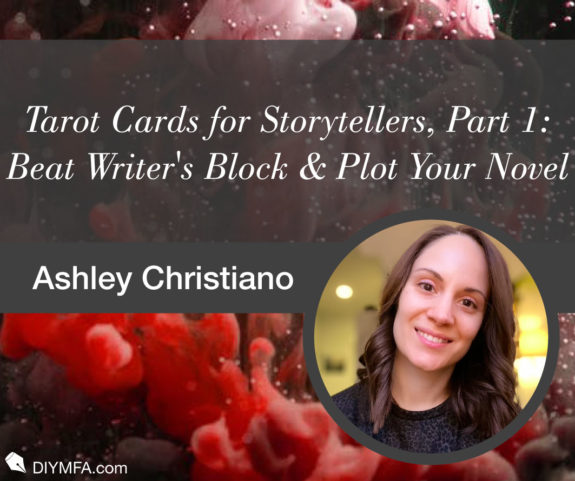In 2015, I wandered into a tarot reader’s shop in NOLA’s French Quarter, curious about my first reading. I’d barely heard of tarot cards but figured this was a thing one did as a tourist in New Orleans. The scent of incense followed me through the storefront and down a hall to a private room stuffed with two comfy chairs, a wooden table, and a psychic with a raspy voice.
Thirty minutes after sitting down, I wandered down that same hallway a different person, my cheeks stained with tears and my puffy eyes hidden behind sunglasses. The experience had been cathartic. I bought my own tarot deck, the classic and widely used Rider–Waite–Smith deck, and once I’d made it back home to NYC, I promptly got down to the business of learning what the heck tarot was and how I could use it.
What Are Tarot Cards?
Like a standard card deck, a tarot deck is made up for four suits (cups, swords, pentacles, and wands), court cards (kings, queens, knights, and with an extra position for pages), and aces through tens. Unlike a standard card deck which contains 52 cards, a tarot deck consists of 78-cards. And it’s those final 22 cards, referred to as the Major Arcana, that make a tarot deck a tarot deck.
Simply put, the Major Arcana tell a story in 22 chapters, starting with the Fool (our innocent protagonist), stumbling through a meet-cute (The Lovers), advancing through an inciting incident (The Wheel of Fortune), hitting rock bottom (The Tower), and finding closure (The World).
How Are Tarot Cards Used?
Most people who have heard of tarot cards are aware that they’re typically used for divination. You might go to a fortune teller and have your cards read, or trust in your own intuition and read them for yourself. When you do a tarot reading, you or the medium will lay the cards down in a specific design. This is called a tarot spread. You can think of a spread as an outline or plot map. Each spot in the spread has its own purpose, and the way the cards fall will give meaning to that purpose.
But for the skeptics out there, tarot cards can be for much more than divination. They can be used for reflection and mindfulness. For example, I draw a card every morning and journal about what it brings up for me, both at the beginning and end of the day.
The more you use the cards, the more naturally their meanings will come to you…and the faster you’ll get at interpretation when you start using the cards for writing.
How Can I Use Tarot Cards as a Writer?
Tarot cards are a great tool for writing for many reasons. They’ve helped me beat writer’s block, brainstorm new book ideas, get through a challenging chapter revision, add depth to characters, or even inspire full-length fantasy novels.
I love that you can use tarot cards in a rapid-fire way to generate some creativity and inspiration (draw a card until it speaks to you!), or build out more complex spreads as a novel outline.
Let’s take a more tactical look at how you might use tarot as a writing tool.
First of all, it’s important to note that there are both positive and negative cards, which makes it possible to build a mix of highs and lows into a spread. I, for example, often have a hard time being “mean” to my characters. When I am not sure how to add tension into a scene, I might draw a tarot card and see what that sparks. If it features a rushing knight on horseback, maybe I need a change of pace or something to go to battle for. If it features a sad-looking person, maybe I need some big emotional moment. If I draw The Emperor, maybe an external institution is making life hard for my protagonist.
The court cards (king, queen, knight, page) can also be great for coming up with ideas for side characters. For example, say you’re writing a RomCom and trying to give your main character’s best friend more dimensionality. You shuffle your court cards, draw one, and see what it inspires. Maybe you draw a king and decide your protagonist’s BFF is a buff dude she formerly dated. Think of the delicious tension that could create in your story! Or you draw a page, and the best friend brings a lovely sense of innocence and optimism that balances out your snarky character’s personality.
You can also use the tarot cards to design on-the-fly writing prompts. Draw one card and then give yourself 15 minutes to tell the story of that card. Or design mini-spreads and build a story from there. Here are a couple of two- or three-card examples you might adopt as a writing prompt:
- Card 1 = Protagonist, Card 2 = Antagonist
- Card 1 = Goal, Card 2 = Challenge
- Card 1 = Inner World, Card 2 = Outer World
- Card 1 = Beginning, Card 2 = Middle, Card 3 = End
- Card 1 = Protagonist, Card 2 = Love Interest, Card 3 = Meet Cute
And lastly, you can design longer spreads if you’re looking to build the outline for a new novel. For example, you might turn The Hero’s Journey framework into a spread. You shuffle your deck, lay the cards down all in their proper order, and then, if you’re like me, you turn that into a spreadsheet. You type up what the cards are showing you into the basic outline for your new project and can refer to it as you begin your writing journey.
This will likely take you some time, as any plotting device will. But don’t feel compelled to rely solely on your own tarot card interpretive abilities—especially if you’re new to tarot.
Another bonus of using tarot cards? There is a massive amount of online resources about the cards, especially if you’re using the Rider–Waite–Smith deck! Google a card and a wealth of knowledge and interpretations will come up to inspire you further. You can even Google a card and a topic to get more specific (like “Three of Cups” and “Career” or “Ten of Swords” and “Love”).
Happy writing! And remember, you are not bound to the way the cards fall. They’re simply a tactile tool to jumpstart creativity and help you think outside of the box.
Tell us in the comments: Have you ever used tarot cards in your writing? How did it go?

Ashley Christiano is a fantasy writer, experienced tarot reader, and professional astrologer. As The Novel Mystic, she combines the power of astrology, tarot, and creative writing to empower women, educate the astro-curious, and inspire her own storytelling. You can find her on her website or follow her on Twitter or Instagram to learn more or get your own reading.







